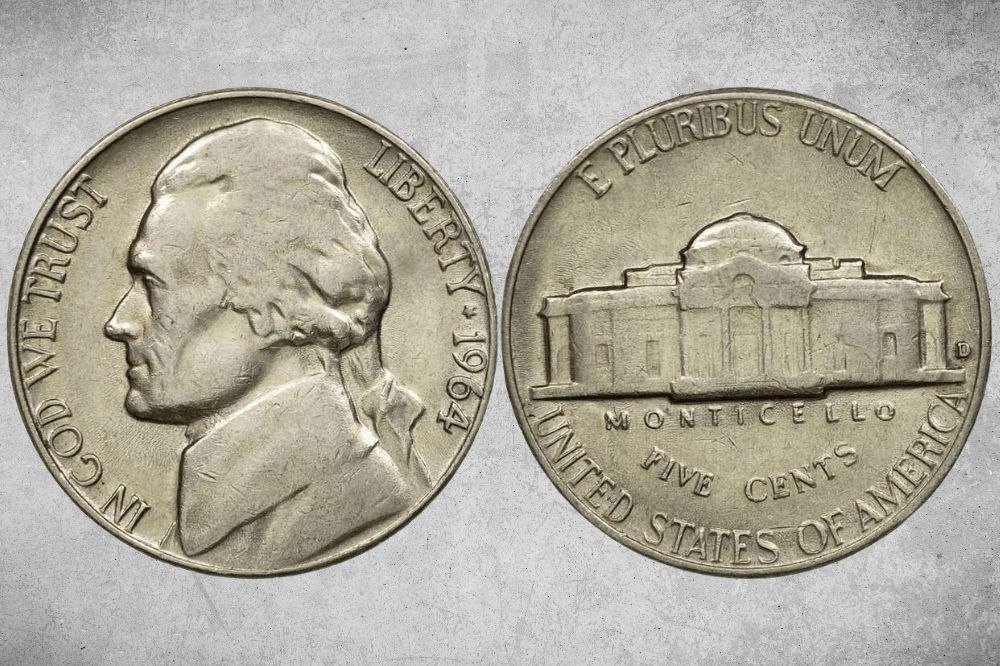Nickels are a common coin in circulation and have been since the middle of the nineteenth century and have earned their place in numismatic history due to some of its dates’ unique features and scarcity. And for collectors, some of these coins can be quite valuable.
But what is the value of the 1964 nickel? Minted nearly 100 years after the very first five cent piece in the United States, you may be wondering if it has any value. In this blog post, we’ll take a closer look at the 1964 nickel and explore if it holds value today.
We’ll also discuss its history, design, and any production errors that make certain versions rarer than others, as well as how much they can be worth in different conditions, such as “Good” all the way to “Uncirculated.” Whether you’re an avid collector or just interested in learning more about coins from U.S. history, you won’t want to miss out on this comprehensive guide to the Jefferson nickel from 1964!
1964 Nickel Details
- Category: nickel
- Mints: Philadelphia and Denver
- Total mintage: 2,815,919,922
- Obverse designer: Felix Schlag
- Reverse designer: Felix Schlag
- Edge: plain
- Diameter: 21.2 millimeters (0.835 inches)
- Thickness: 1.95 millimeters (0.077 inches)
- Composition: 75% copper, 25% nickel
- Weight: 5 grams
The nickel has seen several design changes throughout its time in circulation, including the original Shield nickel, the Liberty nickel, the famous Buffalo nickel, and the Jefferson nickel – however, the Jefferson nickel is one of the most iconic.
Featuring the right-facing profile of Thomas Jefferson, it has become known as the “Jefferson Nickel” and was first issued in 1938. 1964 saw the 26th year of this design, which was originally designed by Felix Schlag – a German immigrant and sculptor.
The reverse features Jefferson’s home Monticello set against a backdrop of mountains, which can be seen well on uncirculated versions as opposed to circulated coins.
The Jefferson nickel is still minted today.
Also Read: 15 Most Valuable Nickels Worth Money
Value Chart
1964 Nickel Value Chart |
|||||
| Mint Mark | Good | Fine | Extremely Fine | Uncirculated | Proof |
| 1964 No Mint Mark nickel | – | – | – | $0.28 to $11 | $3.38 |
| 1964 D nickel | – | – | – | $0.28 to $11 | n/a |
1964 Nickel Values and Varieties
Now that we’ve gone over some of the background details, let’s talk about how much a 1964 nickel can be worth. In terms of value, the 1964 nickel is worth 5 cents at face value, but the value is different when it comes to selling to coin collectors. Here is an explanation of the valuation of 1964 nickels, separated out by US Mint location and condition grade.
1964 “No Mint Mark” Nickel
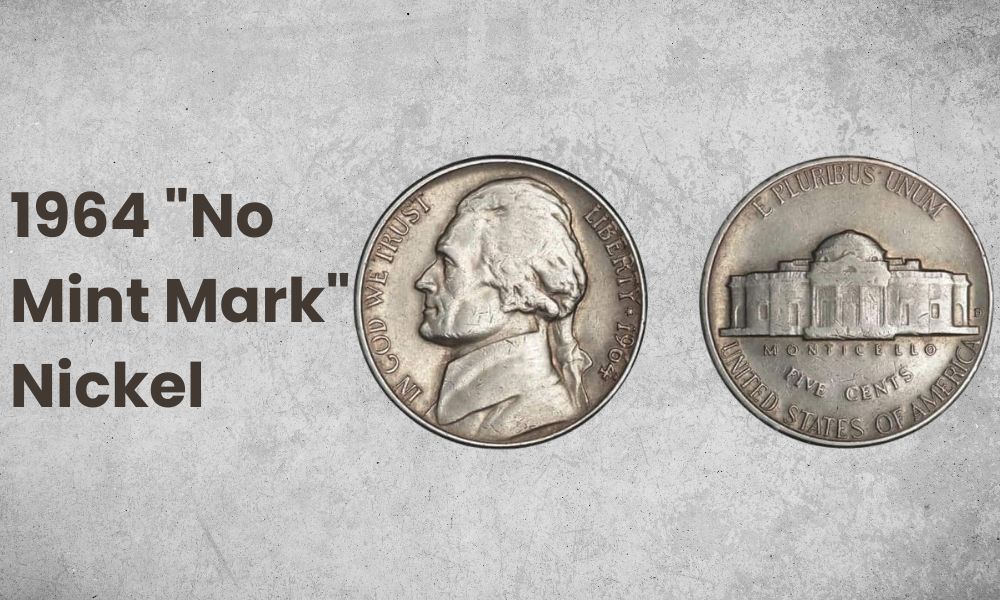
- Type: Nickel
- Edge: Plain
- Mint mark: No Mint Mark
- Place of minting: Philadelphia
- Year of minting: 1964
- Face value: $0.05
- $ price: $0.05 to $11
- Quantity produced: 1,028,622,762
- Designer: Felix Schlag
Minted in Philadelphia, the 1964 “No Mint Mark” nickel is one of the most common varieties. At this location about 1,028,622,762 were produced! That is quite a few, which of course means that the value isn’t super high, generally speaking.
In terms of value, the 1964 nickel holds to its face value of 5 cents at the “Good” condition, “Fine” condition, and “Extremely Fine” condition level. “Uncirculated” coins have a big range and can be worth anywhere from about $0.28 to a whole $11!
There was also a Proof coin issued in 1964 at Philadelphia and these have a value of about $3.38.
1964 “D” Nickel
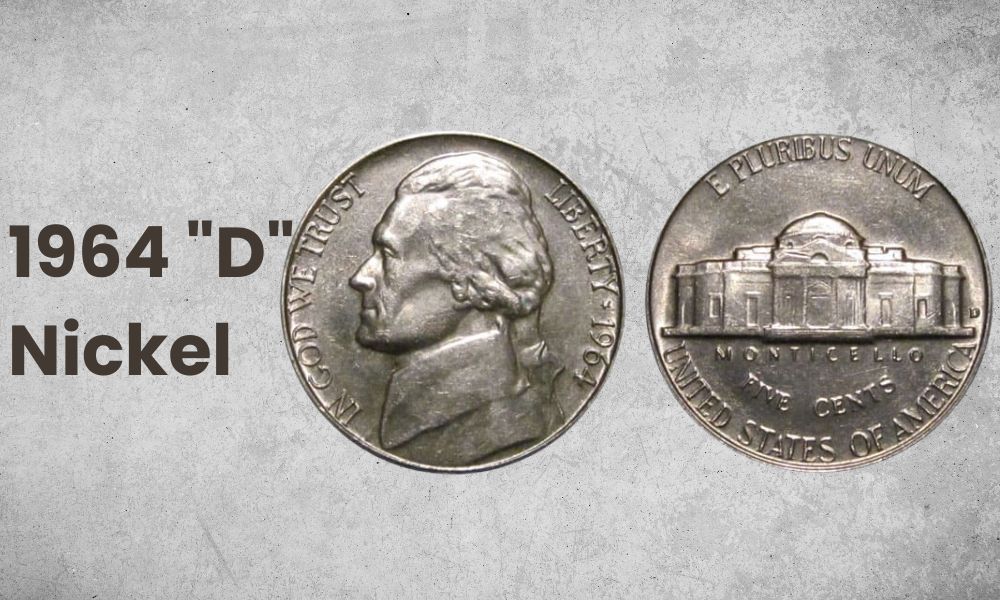
- Type: Nickel
- Edge: Plain
- Mint mark: No Mint Mark
- Place of minting: Philadelphia
- Year of minting: 1964
- Face value: $0.05
- $ price: $0.05 to $11
- Quantity produced: 1,787,297,160
- Designer: Felix Schlag
Nickels stamped with a “D” mint mark were produced by the Denver Mint and are very common. The Denver Mint actually produced around 1,787,297,160 nickels in 1964, which is a larger amount than at the Philadelphia Mint, and so again it is not particularly valuable – certainly no more than the Philadelphia minted nickels of the same year.
In “Good” condition, the 1964 “D” nickel brings in its face value of 5 cents. In fact, it is worth its face value for “Fine” condition and “Extremely Fine” condition, as well. The only space in which it is worth more than its face value is in the “Uncirculated” condition grade.
In near mint condition, they can bring in about $0.28. In pristine mint condition, it can be worth about $11, which is not bad for a five cent piece!
If you are wondering about the value of the Proof coin, there is no need to. There were no Proof coins for this mint location in 1964.
Also Read: Top 110 Most Valuable Nickels Worth Money
History of the 1964 Nickel
The 1964 nickel was issued during a tumultuous time in U.S. history. The nation was still reeling from the assassination of President John F. Kennedy and the Vietnam War was in full swing. Despite the upheaval, coins such as the Jefferson nickel provided a sense of stability for Americans in uncertain times.
But the nickel wasn’t always the 5 cent piece that we recognize today. In fact, it was originally a 3 cent piece, back during another tumultuous time in the United States – the American Civil War. It became a 5 cent piece as we know it in 1866.
As mentioned earlier in this blog post, the nickel originally was the Shield nickel, and then became the Liberty nickel. Thirdly, it became the Buffalo nickel, and lastly, the Jefferson nickel. Featuring the face of Thomas Jefferson for the first time in 1938, that design has been produced ever since.
The Jefferson nickel is one of the most iconic coins from this era, known for its stability, beauty, and its long history. While it may not be worth a lot of money in terms of monetary value, it certainly holds great sentimental value – something collectors can treasure in order to remember a part of history and gain a little financial reward from their value as well.
Also Read: Top 19 Most Valuable Jefferson Nickels Worth Money
1964 Nickel Grading
If you have nickels lying around, you may be wondering how you should go about grading them – if there are signs you should watch for or if there is something you should talk to.
When it comes to grading 1964 nickels, there are a few things you should keep an eye out for. You’ll want to look for signs of wear or damage on the obverse and reverse designs; these can affect the grade and therefore, the value of the coin.
You should also pay special attention to any errors on the coin – this could drastically increase its value! As always when dealing with coins, be sure to handle them carefully so as not to cause any further damage.
Finally, if you think that you may have a rare or valuable 1964 nickel, then it’s best to take it in for authentication by a professional numismatist. This will give you an accurate assessment of its condition and value.
The amount of wear a coin has received can drastically impact its value. Most coins that have circulated in commerce will have some signs of wear, but those that are graded may be categorized as “Good”, “Fine,” or “Extremely Fine” by a professional grading service.
There are “Uncirculated” coins as well. They, on the other hand, show no visible signs of wear from use and can bring significantly higher prices than those with less impressive grades.
1964 Nickel Error Coins
Despite its long production run, there are some errors that occurred during the manufacturing process that have made certain versions of this coin even rare than others—and therefore more valuable. Possible errors could include off-center strikes, double-die coins, those with repunched dates or mint marks, and the list goes on and on.
If you come across a 1964 nickel with any of these features or others, make sure to get it authenticated by a professional coin grading service in order to determine its value.
Let’s look at a few 1964 nickel error coins that have recently surfaced and sold and auctioned:
1964 “No Mint Mark” Nickel – Improperly Annealed Planchet
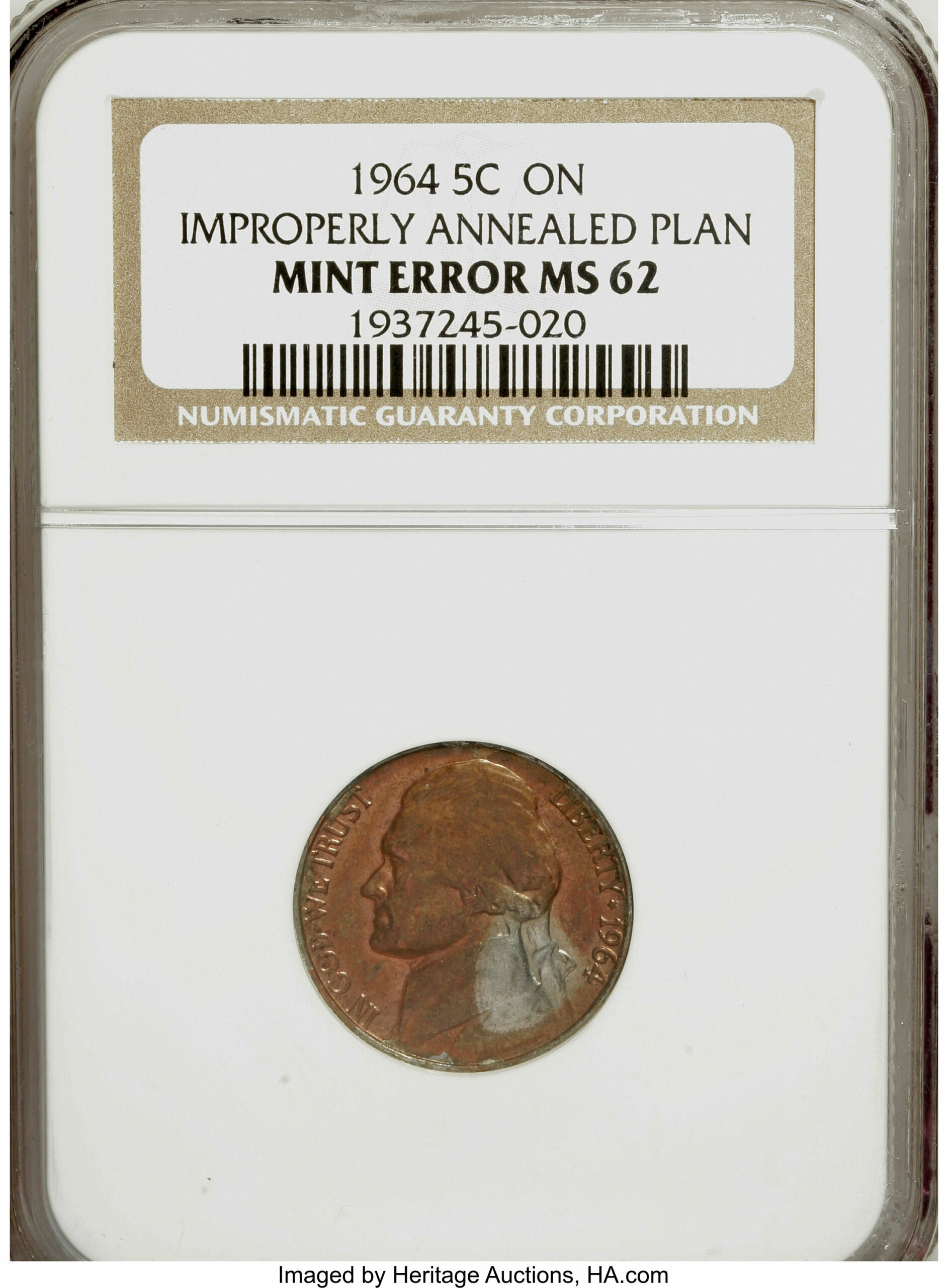
One error that someone found recently and sold at auction was a 1964 “No Mint Mark” nickel. This coin had an improperly annealed planchet, which caused it to have a coppery color with only small hints of its signature nickel coloring. This happened during the minting process.
Thankfully, the coin was given a high grade of mint state 62 by NGC (Numismatic Guaranty Corporation) and sold for $40 at auction.
1964 “No Mint Mark” Nickel – Broadstuck with Obverse Brockage
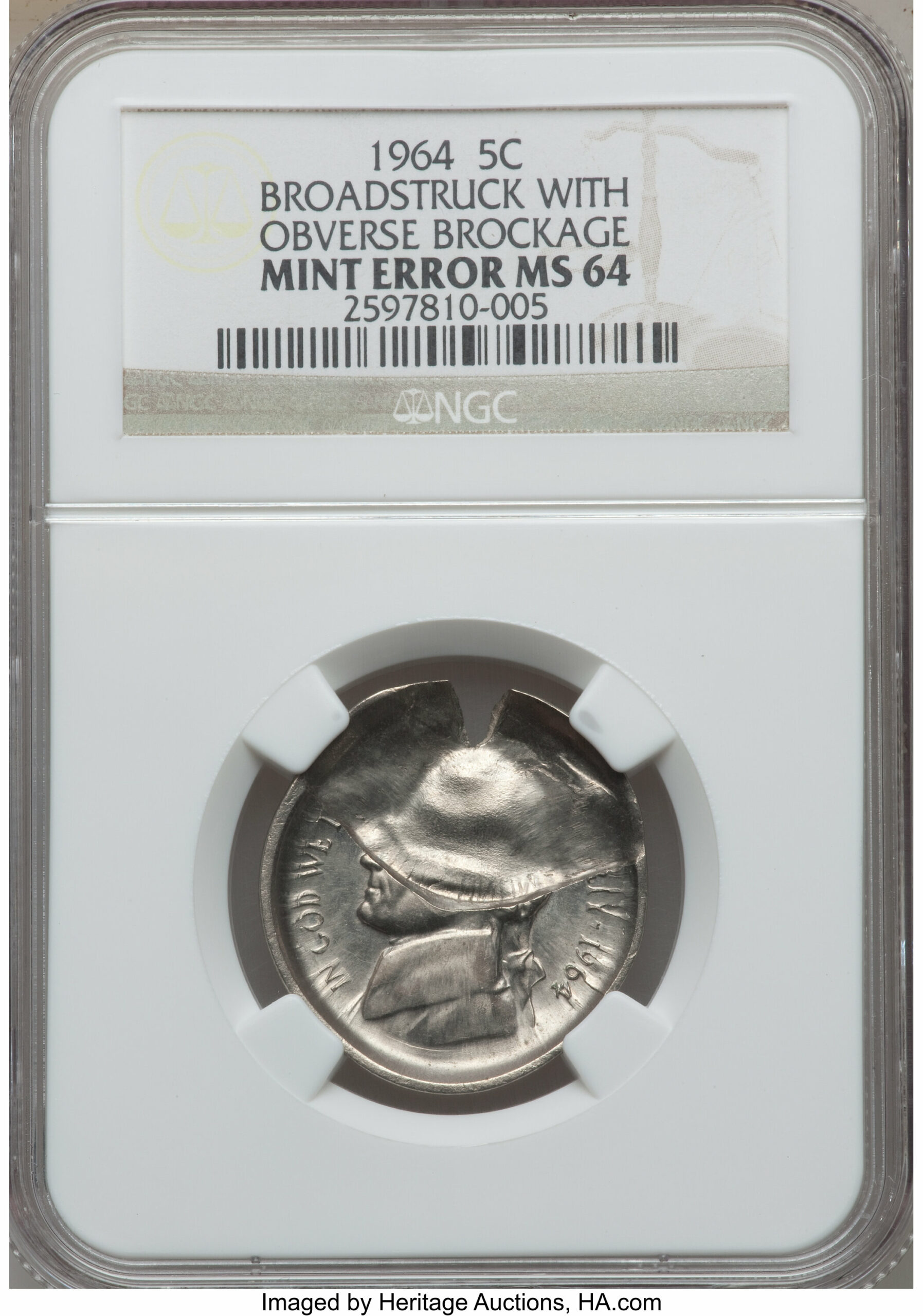
Another 1964 nickel that sold at auction was an improperly struck example. Known as a broadstuck with obverse brockage, this coin had the design on both sides but the design on the front was heavily compromised along the top, due to the broadstrike. The brockage, or rip-like tear, in the coin was also at the top.
It sold for $55 at auction and was graded mint state 64 by NGC.
1964 “D” Nickel – Repunched Mint Mark
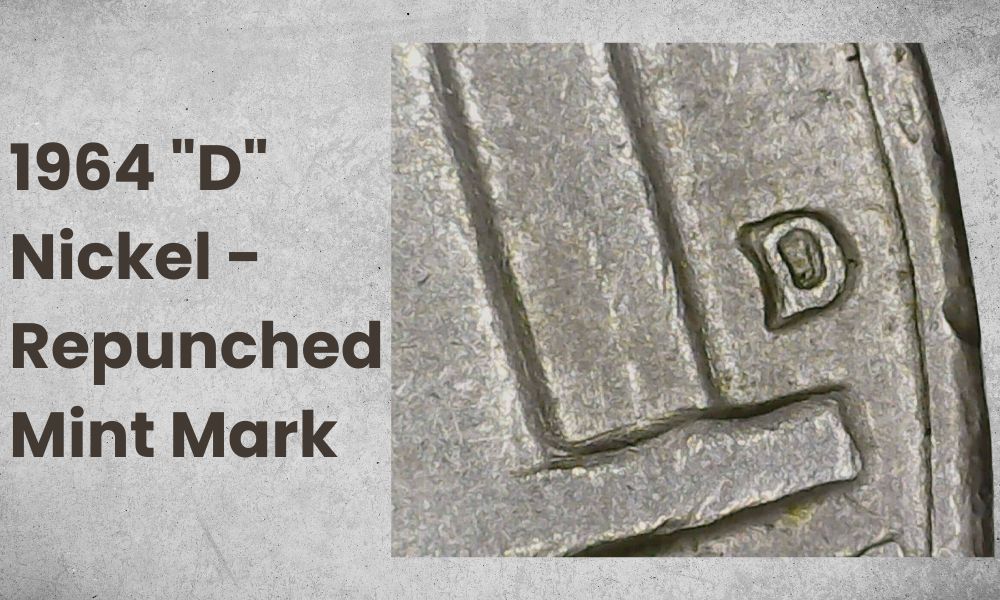
Finally, a 1964 “D” nickel was recently sold at auction. This coin had a repunched mint mark, meaning the mint mark (“D”) was punched twice on top of each other. It was graded mint state 65 by PCGS (Professional Coin Grading Service), appearing nearly flawless, except for the fact that it had a repunched mint mark, of course!
And as most errors do, this repunch error caused the nickel’s value to raise. It sold at auction for and amazing $2,800!
1964 Nickel Frequently Asked Questions
Now that we’ve gone over the basics of this coin, let’s answer some frequently asked questions about 1964 nickels.
What Affects the Value of My 1964 Nickel?
The 1964 nickel is a generally common coin with no true major rarity. Its value depends largely on the grade of the coin. The condition of your 1964 nickel can impact its value greatly, so make sure to assess it accurately—anything from “Good” to “Fine” to “Extremely Fine” to “Uncirculated” will do just fine.
Depending on its overall condition, a typical 1964 nickel can be worth anything from 5 cents or way more for any errors or varieties such as off-center strikes, double-die coins, and so on.
What Should I Do If I Think I Have a Rare and Valuable 1964 Nickel?
If you think you have a rare and valuable 1964 nickel then it’s best to take it in for authentication by a professional numismatist who will give you an accurate assessment of its condition and value.
It’s also important to remember that all coins need proper care and handling, so make sure to take good care of your coin, so as not to damage it before selling it somewhere.
Should I Clean My 1964 Nickel?
No, the answer to this question is a resounding no. Professional numismatists collectively advise against cleaning your coin as this could significantly reduce its potential worth. Therefore handle your coin carefully without cleaning it and look up what similar ones are being sold for online before putting money into professional grading services like PCGS (Professional Coin Grading Service) or NGC (Numismatic Guaranty Corporation).
Is the 1964 Nickel Made of Silver?
No, the 1964 nickel is not made of silver. It is made from a 75% copper and 25% nickel alloy that was established in 1866 as the official composition for U.S. 5-cent coins. In fact, all Jefferson nickels minted between 1938 and 1964 are composed of this same alloy, except for the “Wartime Nickels,” which were made of an alloy composed of 56% copper, 35% silver, and 9% manganese.
The years when the “Wartime Nickels” were produced were from 1942 to 1945. They were made this way (and given their iconic nickname) because of the war effort in the United States – the high demand for nickel during World War II made it impossible to use it in coinage as they had done in years prior.
Conclusion
In conclusion, whether you’re an experienced coin collector or simply curious and want to learn more about coins from American history, understanding the background of the 1964 nickel is important if you want to maximize its value. An iconic piece in U.S. history, this coin continues to capture the attention of collectors worldwide.
For collectors and investors alike, this coin can be an excellent way to add some diversity to your portfolio—and potentially gain some nice profits along the way! Be sure to put the Jefferson nickel on your radar! Have fun!
What other questions do you have about the Jefferson nickel? Let us know in the comments below.
